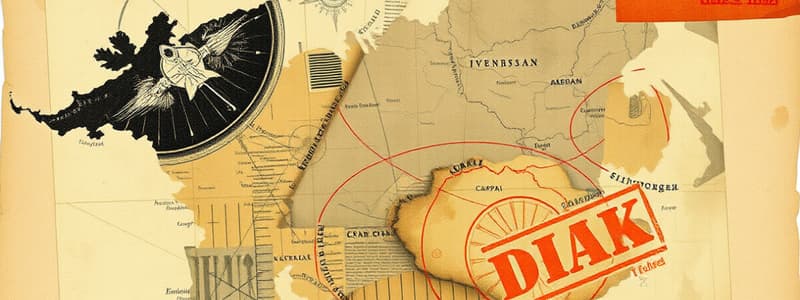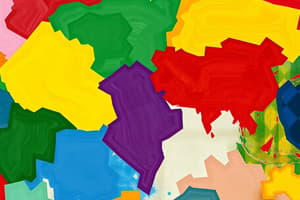Podcast
Questions and Answers
Define boundary.
Define boundary.
An invisible line that marks the extent of a state's territory.
What is the purpose of a boundary?
What is the purpose of a boundary?
To give shape and limitations of a state; they can even have conflict due to conjoining states.
Define frontier.
Define frontier.
A zone where no state exercises complete political control.
Explain the difference between boundary and frontier.
Explain the difference between boundary and frontier.
What is a cultural boundary?
What is a cultural boundary?
Define geometric boundary.
Define geometric boundary.
Define physical boundary.
Define physical boundary.
What is the religious boundary of Ireland?
What is the religious boundary of Ireland?
What is an important fact about Ireland?
What is an important fact about Ireland?
What states joined together due to language?
What states joined together due to language?
What types of boundaries can deserts create?
What types of boundaries can deserts create?
What are the three types of physical elements that serve as boundaries between states?
What are the three types of physical elements that serve as boundaries between states?
Define democracy.
Define democracy.
Define autocracy.
Define autocracy.
Define anocracy.
Define anocracy.
What is a 'failed' state? Give examples.
What is a 'failed' state? Give examples.
What issues do landlocked states face?
What issues do landlocked states face?
What problems do refugees create?
What problems do refugees create?
What is gerrymandering?
What is gerrymandering?
What fraction of the US congressional seats are competitive?
What fraction of the US congressional seats are competitive?
Flashcards are hidden until you start studying
Study Notes
Boundaries and Frontiers
- A boundary is an invisible line demarcating a state's territory.
- Boundaries serve to define state shape and limitations; they can lead to conflicts between adjacent states.
- A frontier is a tangible area where no state has complete political control, differing from a boundary.
Types of Boundaries
- Cultural Boundary: Aligns with cultural features and distributions.
- Geometric Boundary: Defined by straight lines, often irrespective of physical features.
- Physical Boundary: Follows significant natural landscape features like mountains or rivers.
Historical and Regional Boundaries
- Various geographic regions have boundaries separating different linguistic, religious, and ethnic groups.
- The island of Ireland split into Northern Ireland (41% Roman Catholic) and the Republic of Ireland (84% Roman Catholic) due to religious differences.
- The division of India and Pakistan was based on religious lines; India is predominantly Hindu while Pakistan is primarily Muslim.
Conflict Zones and Control
- Cyprus' demographics: 63% Greek and 24% Turkish. The island's control is fragmented, with a UN-controlled buffer zone.
- Geometric boundaries are notable in North America and North Africa, established through treaties and negotiations.
Antarctica and Polar Regions
- The Antarctic Treaty (1959) established conditions for peaceful research in Antarctica.
- Lomonosov Ridge is central to territorial disputes among Arctic states including Canada, Denmark, and Russia.
Physical Elements as Boundaries
- Deserts, mountains, and water are common natural boundaries, aiding in state separation.
- The Sahara Desert acts as a barrier between northern African countries like Algeria and Chad.
- Mountain boundaries, such as the Andes, limit communication and access between states.
Water as a Boundary
- Water boundaries are utilized for territorial waters, contiguous zones, and exclusive economic zones, covering laws on resources and navigation.
- The Rio Grande necessitated treaties due to shifting boundaries affecting US and Mexican territories.
State Shapes and Communication
- A state's shape influences internal communication and social unity, categorized into five types: compact, prorupted, elongated, perforated, and fragmented.
- Compact states allow easier communication; examples include Burundi and Rwanda.
- Elongated states, like Malawi and Chile, face challenges in internal transport and communication.
Landlocked States Issues
- Africa hosts the majority of the world’s landlocked states due to historical colonial decisions.
- Landlocked countries encounter trade difficulties, relying heavily on neighboring states for access to ports and resources.
Government Types
- Types of governments include democracy (citizens elect leaders), autocracy (power rests with a single ruler), and anocracy (combining elements of both).
- The shift toward democracy is characterized by expanded rights, citizen participation, and diffusion from Western nations.
Gerrymandering and Electoral Districts
- Gerrymandering involves redrawing electoral district lines for political advantage, manifesting as wasted, excess, and stacked votes.
- Gerrymandering affects ethnic voting patterns, favoring one party over another, unlike the independent commission model used in Europe.
- Nevada took a stand against gerrymandering practices.
Conflicts and Refugees
- Conflicts in West Darfur involve competition over scarce resources, leading to accusations against the government for neglecting local needs.
- Refugee situations complicate national unity, impacting economies, politics, and cultural cohesion.
Studying That Suits You
Use AI to generate personalized quizzes and flashcards to suit your learning preferences.




